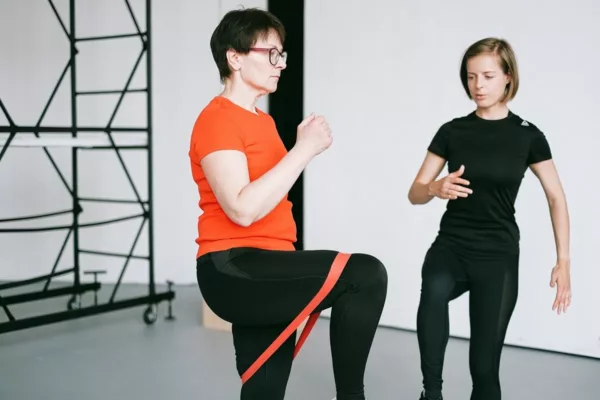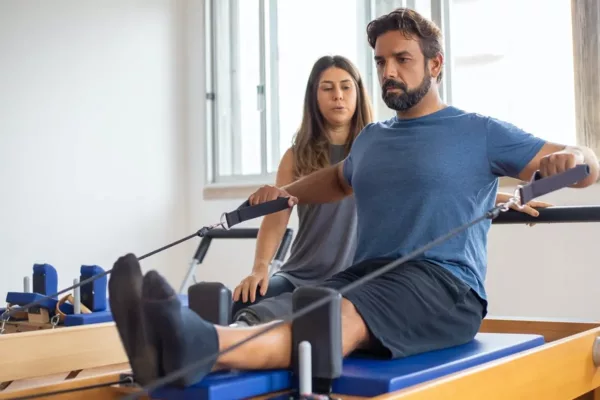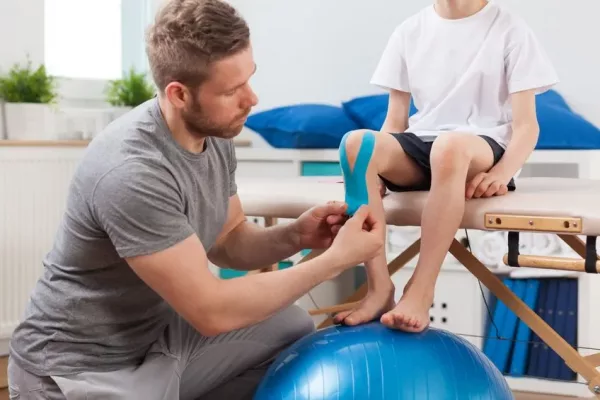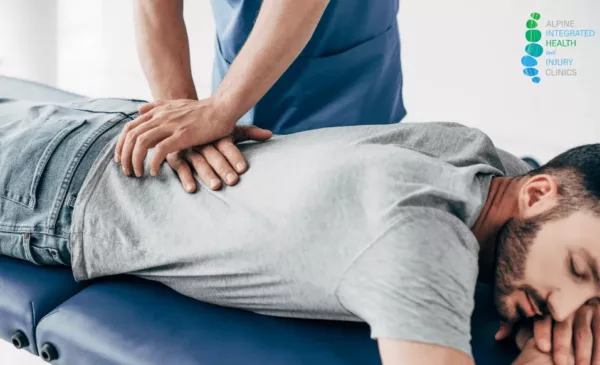Long COVID, also known as Post-COVID Conditions (PCC), refers to a range of new or ongoing symptoms that manifest four or more weeks after contracting the SARS-CoV-2 virus, which causes COVID-19. Individuals with long COVID may experience a wide array of symptoms, including fatigue, cough, chest tightness, shortness of breath, palpitations, muscle pain, and difficulty concentrating.
Physical therapy has proven to be a vital element in managing the symptoms of long COVID. Professionals in this field, such as physical therapists, are instrumental in the recovery and rehabilitation process of those suffering from long COVID. They create personalized physical activity programs with the aim of enhancing lung capacity, functional capacity, and general health.
Long COVID can lead to persistent symptoms like chronic fatigue, joint pain, muscle pain, and decreased endurance. These symptoms can be effectively managed through a mix of strengthening exercises, balance training, and endurance training. Breathing exercises are especially useful for bolstering respiratory function and lung capacity, both of which can be impacted by long COVID.
Healthcare providers keep a close eye on the progress of patients, making necessary adjustments to treatment plans along the way. This could involve ramping up the intensity of physical workouts, introducing resistance training, or concentrating on specific symptoms such as post-exertional malaise or brain fog.
In more severe cases, individuals recovering from stays in intensive care units may require extensive physical rehabilitation. This might include pulmonary rehabilitation to improve lung function and respiratory rate, along with cognitive activities to address the cognitive difficulties frequently reported by long COVID patients.
The goal of physical therapy for long COVID is not just to provide symptom relief, but also to enhance the patient’s quality of life. By improving physical functionality, patients can regain their ability to carry out daily tasks, thereby improving their overall well-being.
Why See a Physical Therapist?
Physical therapy can be extremely beneficial for people suffering from long COVID for several reasons:
-
- Managing Persistent Symptoms: Long COVID often leads to persistent symptoms like fatigue, muscle weakness, joint pain, and breathlessness. Physical therapists can provide exercises and techniques to help manage these symptoms.
-
- Improving Physical Function: Physical therapy can help improve mobility, strength, and endurance, which may have been affected due to long COVID. This can aid in returning to daily activities and improving the quality of life.
-
- Respiratory Rehabilitation: Breathing difficulties are common in long COVID. Physical therapists can guide patients through specific breathing exercises to improve lung function and ease breathlessness.
-
- Personalized Care: Every patient’s experience with long COVID is unique. Physical therapists can tailor a rehabilitation program based on individual needs and progress, ensuring the most effective recovery.
-
- Cognitive Rehabilitation: Some long COVID patients experience ‘brain fog’ or cognitive impairment. Certain physical therapy interventions can help manage these symptoms.
-
- Education and Support: Physical therapists can provide education about managing symptoms at home and the progression of recovery. They can also provide emotional support during what can be a challenging time.
How Does Physical Therapy Help Long COVID Patients?
Physical therapy plays a crucial role in the care and recovery of long COVID patients. It aids in safe rehabilitation and empowers individuals to manage lingering chronic symptoms, which can include fatigue, muscle pain, and joint pain, among others.
Physical therapists are health professionals who bring their expert knowledge into creating tailored programs for patients. These programs generally involve physical activity designed to improve the patient’s functional capacity and overall health. For instance, strengthening exercises may be used to improve muscle strength and balance training can help with stability.
One prevalent symptom of long COVID is breathlessness, often linked to reduced lung capacity. Here, physical therapy is particularly beneficial. Therapists can guide patients through specific breathing exercises aimed at enhancing respiratory function and improving lung capacity. In some cases, more comprehensive pulmonary rehabilitation might be necessary.
Another critical aspect of physical therapy for long COVID is the monitoring and management of persistent symptoms. Health care providers closely monitor patients’ progress and adjust treatment plans as needed. This might involve increasing the intensity of physical exercise or focusing on specific symptoms like post-exertional malaise.
For severe cases, such as patients recovering from stays in intensive care units, physical rehabilitation can be even more critical. Therapists can provide neuromuscular massages to relieve tension, improve circulation, and alleviate pain, which are common issues for long COVID patients.
Therapeutic Interventions for Long COVID
Guided Exercise: Benefits and Precautions
Benefits of Guided Exercise as a Therapeutic Intervention for Long COVID
-
- Improved Lung Function: Guided exercise can help improve lung function by strengthening respiratory muscles and enhancing lung capacity. This is particularly beneficial for long COVID patients who often experience persistent breathing difficulties.
-
- Increased Physical Stamina: Regular guided exercise can boost physical stamina, enabling patients to perform daily tasks more easily and with less fatigue.
-
- Enhanced Cardiovascular Health: Exercise has been shown to improve cardiovascular health, which can be compromised in long COVID patients. Regular physical activity can help reduce the risk of heart disease and stroke.
-
- Better Mental Health: Physical activity has been linked to improved mental health. It can reduce symptoms of depression and anxiety, which are common in long COVID patients due to prolonged illness.
-
- Rehabilitation Support: Guided exercise programs tailored to the individual’s abilities can make an important contribution to rehabilitation efforts, helping patients gradually regain their strength and mobility.
Precautions for Guided Exercise in Long COVID Patients
-
- Medical Supervision: It’s essential that any exercise program for long COVID patients is conducted under medical supervision. The intensity and type of exercises should be adapted to the patient’s current health status.
-
- Gradual Progression: The intensity of exercise should be gradually increased to avoid causing undue stress on the body. Overexertion can potentially exacerbate symptoms or cause injury.
-
- Regular Monitoring: Regular health checks and monitoring are crucial to ensure the safety of the patient. Any signs of distress or discomfort during exercise should be promptly addressed.
-
- Adequate Rest: While exercise is beneficial, adequate rest is equally important. Patients should be encouraged to listen to their bodies and rest when needed.
-
- Hydration and Nutrition: Proper hydration and nutrition are vital when engaging in regular exercise. A balanced diet can help provide the necessary energy and nutrients for recovery.
Pulmonary Rehabilitation: What Research Shows
Research has highlighted the significant role of pulmonary rehabilitation in treating patients with Long COVID, particularly those experiencing persistent respiratory issues.
A study published by Frontiers in Medicine revealed that about 40% of COVID-19 patients continue to face health challenges after discharge, affecting their quality of life long-term. The research emphasized the effectiveness of pulmonary rehabilitation (PR) in improving exercise capacity and overall health status.
Another paper from ScienceDirect noted that a notable proportion of COVID-19 survivors experience residual and long-term effects. Pulmonary rehabilitation becomes an essential therapeutic intervention for these patients, helping them manage their symptoms and improve their lung function.
Furthermore, a prospective observational cohort study on the benefits of pulmonary rehabilitation in COVID-19 patients suggested that this form of therapy could yield long-term benefits. The study recommended further research to better understand these potential long-term benefits.
A different study from MDPI found that comprehensive pulmonary rehabilitation is associated with significant clinical and functional improvements in individuals suffering from severe post-COVID-19 symptoms. This further reinforces the importance of pulmonary rehabilitation in managing long-term consequences of the disease.
Neuromuscular Massage: Alleviating Tension and Pain
The therapeutic intervention for Long COVID varies widely due to the diverse range of symptoms experienced by patients. The approaches range from physical and occupational therapies, cognitive-behavioral therapy, hyperbaric oxygen therapy, monoclonal antibodies to neuromuscular massage therapy.
Neuromuscular massage therapy, a specialized form of deep tissue massage, can be beneficial in managing some symptoms of Long COVID. It focuses on relieving muscle tension and reducing pain, which can be particularly helpful for patients experiencing chronic fatigue and body aches associated with Long COVID.
Monoclonal antibodies, used to treat acute COVID-19 infection, have also shown promise in treating Long COVID according to a study found on Medscape. These lab-made proteins mimic the immune system’s ability to fight off viruses and have been found effective against the virus that causes COVID-19.
Cognitive-behavioral therapy (CBT) has also been utilized as a therapeutic intervention for Long COVID. A study cited by WebMD reported that people with Long COVID significantly reduced their fatigue after completing 17 weeks of CBT. This approach can also help manage mental health concerns such as depression and anxiety, which can result from Long COVID, as noted by UCLA Health.
Physical, speech, and occupational therapies are also integral parts of treatment for long COVID, as mentioned by Brooks Rehab. These therapies aim to improve physical function, speech difficulties, and the ability to perform daily tasks, which can be impaired in individuals with Long COVID.
Hyperbaric Oxygen Therapy (HBOT), advertised as a treatment for long-term COVID-19, involves breathing pure oxygen in a pressurized room or tube, as mentioned by Cognitive FX. This therapy is thought to enhance the body’s natural healing process.
Long Covid symptoms
Long COVID, also known as post-COVID conditions, is characterized by a range of symptoms that persist weeks or even months after the acute phase of the COVID-19 infection has resolved. These symptoms can vary greatly among individuals but often include:
-
- Difficulty thinking or concentrating, often referred to as “brain fog.”
-
- Headaches that may be persistent and severe.
-
- Sleep problems, which can include insomnia or excessive sleepiness.
-
- Dizziness upon standing up, also known as postural lightheadedness.
-
- Fatigue, or extreme tiredness that can interfere with daily activities.
-
- Symptoms that worsen after physical or mental effort, also known as post-exertional malaise.
-
- Fever, which may recur or persist.
-
- Respiratory symptoms, such as shortness of breath, cough, and chest discomfort.
-
- Loss of smell or taste, which may persist for weeks or months.
-
- Muscle aches or pain, also known as myalgia.
Other symptoms can include chronic pain, heart palpitations, gastrointestinal issues, and mood changes like depression or anxiety. Some individuals may develop postural tachycardia syndrome, which is characterized by an increased heart rate upon standing.
Advantages of a multidisciplinary approach
A multidisciplinary approach in using physical therapy for long COVID has several advantages:
-
- Holistic Care: Long COVID affects multiple systems in the body. A multidisciplinary team, including physical therapists, pulmonologists, cardiologists, neurologists, and mental health professionals, can provide comprehensive care that addresses all aspects of a patient’s health.
-
- Individualized Treatment Plans: Physical therapists can work with other health professionals to create personalized treatment plans based on a patient’s specific symptoms and progress. This ensures the most effective recovery.
-
- Improved Symptom Management: Different specialists can focus on managing different symptoms. For instance, physical therapists can address issues like muscle weakness and joint pain, while pulmonologists can help manage breathing difficulties.
-
- Enhanced Communication: With a multidisciplinary approach, communication among health care providers can be improved. This can lead to better coordination of care and ensure that all health professionals are updated about a patient’s condition and treatment progress.
-
- Emotional and Psychological Support: Mental health professionals can provide necessary emotional and psychological support. This is crucial as long COVID can often lead to mental health issues like anxiety and depression.
-
- Education and Guidance: A multidisciplinary team can provide a wealth of information and guidance. This can help patients better understand their condition, what to expect during recovery, and how to manage symptoms at home.
-
- Research Opportunities: Multidisciplinary teams also offer excellent opportunities for research. By working together, professionals from different fields can contribute their unique perspectives and expertise to advance our understanding of long COVID and develop more effective treatments.
Post-COVID-19 Physical Therapy Treatment Plans
Reducing Dyspnea and Improving Lung Capacity
Physical therapy has been identified as a crucial part of the recovery process for patients dealing with long COVID. In particular, it has been found to be effective in improving respiratory function and reducing dyspnea – a condition often characterized by difficulty in breathing or shortness of breath, which is a common symptom among long COVID sufferers.
Key to the role of physical therapy in this context is pulmonary rehabilitation. Numerous studies have shown that this form of therapy can significantly aid in restoring patients’ exercise capacity, which is often diminished due to long COVID. Pulmonary rehabilitation typically involves a combination of breathing exercises and physical exercises designed to improve lung function and reduce fatigue (PCOM Georgia Campus).
Breathing exercises are particularly important for restoring lung function after a COVID-19 infection. These exercises help strengthen respiratory muscles, enhance lung capacity, and improve overall breathing capabilities. It’s worth noting that these exercises may need to be performed for several months after the infection has been treated, as it takes time for the tissues in the lungs to heal (APTA).
Physical therapists also focus on improving cardiovascular endurance, which can be compromised in patients with long COVID. By boosting cardiovascular fitness, patients are better equipped to handle physical exertion without experiencing severe breathlessness (Cognitive FX). This comprehensive approach to rehabilitation empowers patients to manage their lingering symptoms and move towards recovery.
Reduce Depression and Anxiety
Physical therapy can play a significant role in mitigating the mental health challenges, such as depression and anxiety, often associated with long COVID. While physical therapy is often seen as a means to improve physical health, its benefits for mental well-being are increasingly recognized.
-
- Exercise and Physical Activity: A key component of physical therapy is engaging in regular exercise, which has been shown to have a positive impact on mood. Exercise releases endorphins, often known as ‘feel-good’ hormones, which can help to alleviate feelings of depression and anxiety. Moreover, achieving small, incremental goals in physical therapy can also boost self-esteem and provide a sense of accomplishment.
-
- Mind-Body Connection: Physical therapy emphasizes the connection between physical health and mental well-being. By focusing on breathing exercises, posture, and movement, physical therapy can help individuals become more mindful of their bodies. This mindfulness can reduce stress levels and help manage symptoms of anxiety and depression.
-
- Pain Management: Chronic pain is a common symptom of long COVID, and it can significantly contribute to feelings of depression and anxiety. Physical therapists provide strategies and exercises to manage and reduce pain, which can indirectly improve mental health.
-
- Improved Sleep: Regular physical activity can promote better sleep, which is crucial for mental health. Good quality sleep can enhance mood, increase energy levels, and improve overall emotional well-being.
-
- Social Interaction: Physical therapy often involves interaction with healthcare professionals or other patients, which can alleviate feelings of isolation that may exacerbate depression and anxiety.
-
- Education and Support: Physical therapists provide education about the recovery process, which can ease anxieties related to the unknown. They can also provide emotional support and reassurance, helping patients to feel understood and less alone in their journey.
Increase General Fitness and Muscle Strength
Physical therapy is an essential part of the recovery process for post-COVID patients, especially when it comes to increasing general fitness and muscle strength. Many individuals recovering from COVID-19 experience a decline in their physical abilities due to prolonged illness, hospitalization, or simply not being able to maintain their usual level of physical activity during their illness.
Here’s how physical therapy can help:
-
- Individualized Exercise Programs: Physical therapists create personalized exercise programs that cater to each person’s unique needs and abilities. These programs typically involve a mix of aerobic exercises, strength training, balance exercises, and flexibility workouts.
-
- Strength Training: Strength training is a vital component of physical therapy. It can help rebuild muscle mass lost during the illness and increase overall strength. Exercises may start with light resistance and gradually increase as the patient’s strength improves.
-
- Aerobic Exercises: Aerobic exercises help improve cardiovascular fitness, which may be compromised due to COVID-19. This kind of exercise can include walking, cycling, or swimming and progresses at a pace suitable for the individual’s recovery.
-
- Balance and Flexibility Exercises: These exercises are crucial for enhancing mobility and preventing falls, especially in older adults who have been hospitalized. They also aid in improving joint flexibility, which can be affected after a long period of inactivity.
-
- Education: Physical therapists educate patients about safe and effective ways to perform exercises at home, ensuring continued progress outside of therapy sessions.
-
- Progress Monitoring: Physical therapists closely monitor the patient’s progress, adjusting the treatment plan as necessary to ensure optimal recovery.
-
- Motivation and Support: The encouragement and support from physical therapists can be instrumental in motivating patients to stick to their exercise routines, crucial for improving fitness and muscle strength.
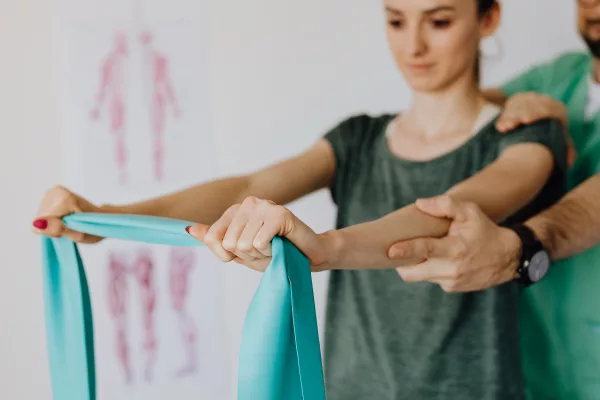
Woman working with Chiropractor
Demographic and Clinical Characteristics of the Patients
The demographic and clinical characteristics of patients receiving physical therapy due to long COVID are quite diverse, given the different ways the disease impacts individuals.
Age plays a pivotal role, with older patients often needing physical therapy owing to the intense nature of their symptoms. Furthermore, people who have pre-existing conditions like heart diseases or movement disorders may also require physical therapy during their recovery from long COVID.
There’s no clear gender predominance among these patients, although some data suggest men might be slightly more affected.
The severity of the original COVID-19 infection also determines who might need physical therapy. Typically, those who had severe symptoms or were hospitalized, particularly if they were in intensive care units, tend to be the ones needing post-acute rehabilitation.
Clinically, these patients usually exhibit ongoing symptoms that interfere with their physical abilities. Symptoms often include fatigue, muscle weakness, joint pain, and breathing difficulties. The existence of these symptoms generally calls for a thorough rehabilitation program, which includes physical therapy.
